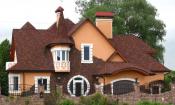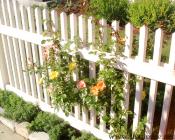Search
Login
Recommended
Rockery, its features, how to make do-it-yourself rockery
According to landscape designers, a rockery, or a rocky flower garden, is an element that can give a boring leveled summer cottage a volume comparable only to the 3D effect. Rockery is a landscape composition, the purpose of which is an artistic combination of living plants and stones.
Content
- The main differences of the rockery
- Creating a rockery - planning stage
- How to make a rockery video video
- How to choose plants for rockeries
- Some tips that may come in handy video
The main differences of the rockery
A rockery is a small flower garden or kindergarten that can be arranged on a flat plot. It is the horizontal basis of the rockery that is its main difference from the alpine hill. Its construction will not require much effort, to create a beautiful composition you will need knowledge of the basics of working on the proper installation of stones, selection and planting of plants. They usually resort to the construction of a rockery if there is no opportunity to build a decorative slide on the site. Subsequent care of the rockery also does not cause much trouble.

Today it is customary to apply several styles in the construction of the rockery:
- Japanese, in which the main emphasis is on stones - they prevail in the composition, create the effect of a special pacification and adjust to thoughts about eternity. Plants are intended only to emphasize the splendor and sophistication of natural stone.
- The European style to a greater extent copies the usual motifs of landscapes of the middle strip, it pays equal attention to the composition of living plants and stone objects.
- The English style involves the creation of a long-lasting composition with the planting of obligatory conifers.
But no matter what scheme of the rockery you follow, it will consist in planting beautiful diverse plants between stones of an unusual, eye-catching form.
Creating a rockery - planning stage
In order for our man-made landscape to be attractive and pleasing to the eye, it is necessary to provide for the presence of elements in it that connect it with lawns, ponds, paths, and trees growing in shrubs that already exist near. Artificial beds of live streams or dried out look good in a stone and plant composition.

Under the rockery in the country, you can take a place well lit by the sun, its area may be small - from 5 to 10 square meters. It will be quite enough to create a spectacular flower garden with minimal financial costs. Caring for such a territory will not be a burdensome task, because you will have to pay attention to your creation from early spring until late autumn. The selected area should have a flat surface or one that will not be difficult to give the desired shape. At the planning stage, they also think over which plants for the rockery can be used.
How to make do-it-yourself rockery
On a leveled place, determine the points where the stones will be located, lay pieces of film under their base. This will prevent weeds from growing under the stones, which can be difficult to remove. The stones should be laid down with the flat side, but at the same time they should be placed so that the point, if any, is not at the top.
Available stone fragments should be divided into groups in which individual elements will be well combined with each other in shape and shade. Alluvial deposits are created from stones with a diameter of up to 20 cm, larger specimens are arranged in groups of several pieces, beautiful large stones are placed one at a time, plants are planted around them. If the rockery is adjacent to the vertical plane of the wall or fence - large stones are shifted in its direction.

If it turns out that the stone is not stable enough on the ground, then it can be dug a little into the ground. Under the base, you can pour gravel, it will be good drainage. Between large stones, you can equip areas covered with a layer of gravel, its color should be contrasted with the nearby stones, this will emphasize their beauty and grandeur. Many-colored pebbles look very attractive in such compositions.
On the territory of the rockery, the presence of paths should be provided - they will be a wonderful picturesque addition to the composition and will give access to the most remote corners of the stone flower bed for the careful care of the green spaces located on it. It is not necessary to cover the whole area with stones - the beauty of the rockery consists in the alternation of stones and plants. Now we will consider which of them will be most suitable for planting on a stone flower bed.
How to choose plants for rockeries
Firstly, there should not be many plants, they should not be allowed to overlap stones. Stones can be allocated about half the area, plants should simply emphasize their beauty. You should pay attention to the decorative, with a bizarre form of shrubs, possibly evergreen, or in extreme cases, characterized by high decorativeness. They should not be tall, the formation of dense thickets should also not be allowed. Coniferous plants should be slow-growing, give in to a haircut. You will need to perform it 2-3 times during the season. Plants that tend to give active shoots should be avoided. It is not recommended to get involved exclusively in alpine plants - caring for them can be too problematic.

From undersized herbaceous plants, perennials such as tulips, snowdrops, mouse hyacinths, crocuses, periwinkle, creeping thyme, Carpathian bell, wild violet can be preferred. Coniferous dwarfs and decorative dwarf shrubs will organically complement the picture.

Alpine plants can also adjoin the plants of the middle zone, the main thing is that they are not very fastidious in care and aesthetically combined with the rest of the plantings. In addition, it should be noted that alpine and subalpine vegetation will require special soils, it also has higher requirements for climatic conditions and soil moisture. Such plants should be arranged in a special way so that their rhizomes are maximally obscured by nearby stones, which will to some extent correspond to their natural habitat.

On sale today there are quite a variety of crops for planting in rockeries, but you can stop only on some of them. For the initial planting, it will be enough to use a dozen species, then, with the formation of a stone-plant garden, it will be possible to slightly vary its content.
Some tips that may come in handy
- Getting started, carefully consider the rockeries in the photo, it is easier to get inspired with ideas that professional designers have embodied in reality.
- It is not necessary to achieve symmetry in the arrangement of the components of the composition, it is desirable that when it is examined, an odd number of stones are in the field of view.
- Aviators should not be planted in rockeries - plants should be decorative from spring to late autumn, in winter they should also look attractive.
- Lichens or mosses that have appeared on the stones should not be removed.
- There should be nothing superfluous in the composition - every detail and every stroke should seem to be the main thing.





